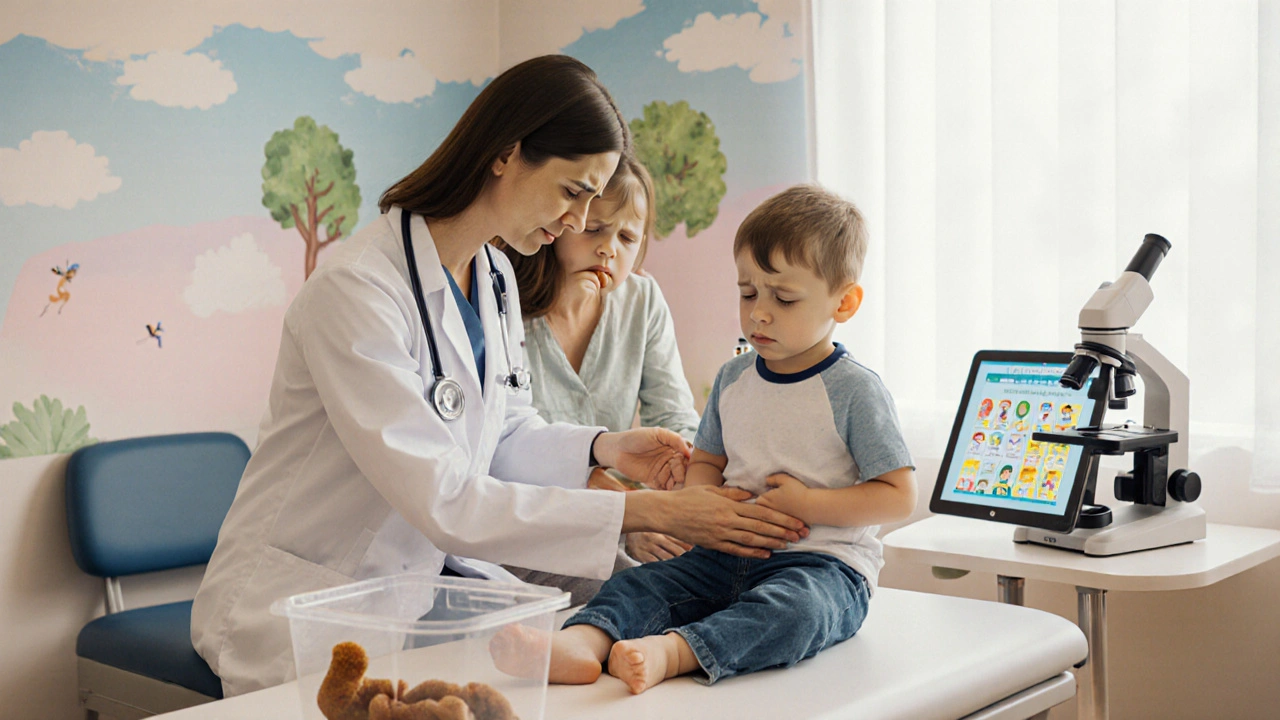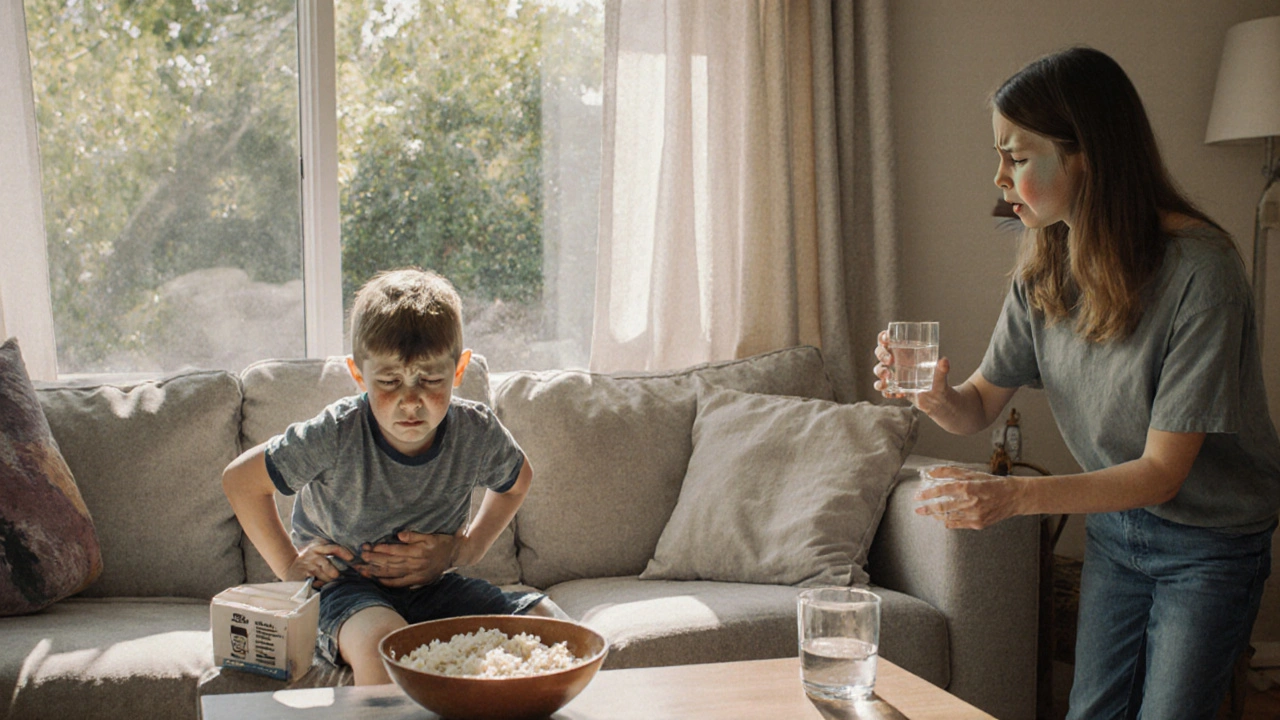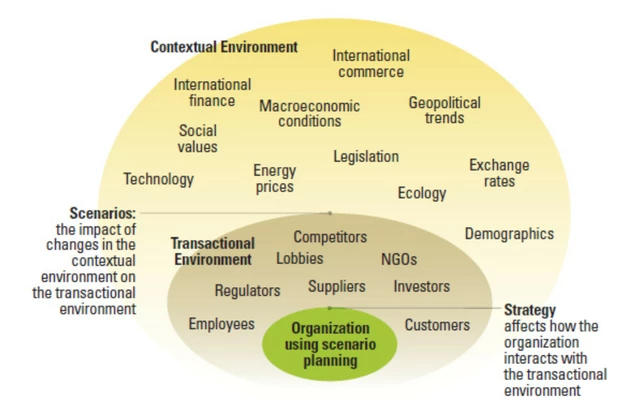Amebiasis in Children: Symptoms, Diagnosis & Effective Treatment

Amebiasis in Children is a parasitic infection caused by Entamoeba histolytica that primarily affects the gastrointestinal tract of infants and school‑age kids. The disease spreads through contaminated water or food and can range from mild diarrhea to severe dysentery. Early recognition and accurate testing are essential to prevent complications and protect a child’s growth.
Key Symptoms to Watch For
Children rarely describe what they feel, so parents need to look for concrete signs. The most common manifestations include:
- Frequent, watery stools that may turn bloody or contain mucus
- Abdominal cramps that worsen after meals
- Fever up to 38.5°C (101.3°F) in severe cases
- Unexplained weight loss or poor weight gain
- Fatigue and irritability, especially after meals
When symptoms persist longer than a week or are accompanied by blood, seek medical care promptly.
How the Parasite Gets Inside
Entamoeba histolytica Entamoeba histolytica is a single‑celled protozoan that thrives in warm, moist environments. The main transmission routes are:
- Drinking untreated or poorly filtered water
- Eating raw vegetables or fruits washed with contaminated water
- Contact with feces‑contaminated surfaces, common in daycare settings
Children in low‑resource communities or those traveling to endemic regions are at the highest risk.
Diagnosing Amebiasis in Kids
Because the symptoms overlap with bacterial or viral gastroenteritis, laboratory confirmation is crucial. Three core tests dominate the diagnostic landscape:
| Test | Turnaround Time | Sensitivity | Specificity | Typical Use |
|---|---|---|---|---|
| Stool Microscopy | Same day | ~60% | ~90% | First‑line in low‑resource clinics |
| Antigen Detection (ELISA) | 4‑6hours | ~85% | ~95% | Mid‑tier labs, higher accuracy |
| PCR (Polymerase Chain Reaction) | 24‑48hours | >95% | >98% | Reference labs, used for complex cases |
Stool microscopy remains the cheapest option, but its lower sensitivity can miss low‑grade infections. Antigen tests strike a balance, while PCR offers the highest accuracy, especially when mixed infections are suspected.
For children, collecting a clean stool sample is essential. Parents should avoid contamination with urine or water and store the sample in a sealed container.
Treatment Protocols Tailored for Children
Effective therapy clears the invasive trophozoites and then eliminates any lingering cysts in the gut. The standard two‑step regimen includes a tissue‑active drug followed by a luminal agent.
- Metronidazole - 7‑10days, 30‑50mg/kg/day divided TID. This kills the invasive form that breaches the intestinal lining.
- In regions with high metronidazole resistance, Tinidazole (single daily dose, 30mg/kg) may be used for 3days.
- After the tissue phase, a luminal agent like Paromomycin (25‑35mg/kg/day divided BID for 7days) eradicates cysts and prevents relapse.
Always verify dosing with a pediatrician, as weight‑based calculations are critical. Side‑effects such as nausea or metallic taste are common with metronidazole but usually resolve after therapy ends.
For severe disease with liver abscesses, hospitalization and intravenous agents (e.g., metronidazole IV) become necessary.

Preventive Measures Parents Can Take
Prevention is more than clean water; it’s a habit checklist for the whole family:
- Boil or filter drinking water, especially during travel.
- Peel or thoroughly wash raw fruits and vegetables.
- Teach kids proper hand‑washing after bathroom use and before meals.
- Avoid sharing utensils or bottles that may have been in contact with unclean oral fluids.
- In daycare, ensure regular sanitation of toys and bathroom facilities.
Vaccines against amebiasis are not yet available, so hygiene remains the frontline defense.
Related Topics and Further Reading
Understanding amebiasis touches on several adjacent concepts that families often encounter:
- Travel‑related diarrhea - how to differentiate from amebic infection.
- Giardiasis - another protozoan causing similar symptoms.
- Malnutrition and intestinal parasites - the bidirectional impact on child growth.
- Water‑borne disease surveillance - why public health monitoring matters.
Each of these topics deepens the picture of how parasites affect pediatric health and why prompt medical care matters.
Quick Recap for Busy Parents
Remember the three‑step approach: watch for blood‑streaked stool, abdominal pain, and prolonged fever; get a stool test - ideally antigen detection or PCR; and follow the two‑phase drug regimen (metronidazole+paromomycin). Keeping water clean and hands washed reduces the odds of a repeat infection.
Early detection and proper treatment can protect a child’s growth trajectory and keep the whole family safe from this preventable parasite.
Frequently Asked Questions
Can amebiasis be caught from a sibling?
Yes. If one child has an active infection, the cysts can spread through shared bathroom surfaces or contaminated toys. Good hand‑washing and bathroom hygiene break the chain.
How long does it take for symptoms to improve after starting treatment?
Most children feel better within 48‑72hours of beginning metronidazole. Full stool clearance may take the entire 7‑10day course, so finish the prescription even if they seem well.
Is it safe to give metronidazole to infants under 2 years?
Yes, when dosed by weight and supervised by a pediatrician. Studies from the WHO show excellent safety records for children as young as 6months.
What if the stool test is negative but symptoms persist?
A negative microscopy result doesn’t rule out amebiasis. Request an antigen test or PCR, and consider other parasites like Giardia or bacterial pathogens.
Can amebiasis cause long‑term gut problems?
If untreated, the parasite can create ulcers or lead to malabsorption, impacting growth. Prompt treatment usually prevents lasting damage.
Is there any vaccine on the horizon?
Research is ongoing, but as of 2025 there is no approved vaccine. Public‑health measures remain the primary prevention tool.
How does amebiasis children differ from adult infection?
Kids often present with more watery diarrhea and may be less likely to develop severe liver abscesses. Their immune systems also react differently, making early testing crucial.






John Keough
September 27, 2025 AT 21:06When you spot those watery stools in a kid, think about the water source they’re drinking – even a tap that looks clean can hide cysts. Boiling for one minute or using a certified filter can knock out Entamoeba histolytica before it gets a foothold. Also, make sure any fruit you serve has been scrubbed under running water, not just rinsed in a bowl that might have been sitting out. Hand‑washing after bathroom trips and before snacks cuts the transmission chain dramatically, especially in daycare settings where toys get swapped around all day.
Graham Smith
September 28, 2025 AT 11:00I noticed a tiny typo in the dosage line – it should read “30‑50 mg/kg/day”, not “30‑50 mg/kg/dy”. Small errors can cause big confusion when parents are dosing.
Jeremiah Morgan
September 29, 2025 AT 00:53Early detection of amebiasis in children is paramount, as the parasite can quickly impair nutrient absorption and stunt growth. The clinical picture often mimics viral gastroenteritis, which can delay appropriate therapy if not investigated thoroughly. Stool antigen detection offers a rapid turnaround with high sensitivity, making it a valuable first‑line test in many outpatient settings. When antigen results are equivocal, PCR provides definitive identification and can differentiate mixed infections that might otherwise be missed. Treatment should begin promptly once the diagnosis is confirmed, employing metronidazole to eradicate invasive trophozoites. Following the tissue‑active phase, a luminal agent such as paromomycin is essential to eliminate residual cysts and prevent relapse. Dosing must be weight‑based; a child weighing 20 kg typically receives 600 mg of metronidazole divided into three doses daily. Parents should be counseled about the metallic taste and transient nausea that often accompany metronidazole therapy. Monitoring stool consistency throughout the course helps verify that the infection is clearing. In severe cases with hepatic involvement, intravenous metronidazole combined with percutaneous drainage may be required. Public health measures, including water treatment and sanitation improvements, remain the cornerstone of prevention. Education of caregivers regarding hand‑washing and safe food preparation can dramatically reduce transmission in community settings. Finally, follow‑up stool testing after completion of therapy ensures that no cysts persist, safeguarding the child’s long‑term health.
nina greer
September 29, 2025 AT 06:26One must appreciate the nuanced interplay between host immunity and parasitic virulence.
Montague Tilmen
September 29, 2025 AT 14:46America shouldn’t cower over a few parasites; our infrastructure can handle it.
Clarise Wheller
September 29, 2025 AT 20:20I totally agree – emphasizing clean water and hand hygiene is the most practical step we can all take right now.
Riley Fox
September 30, 2025 AT 04:40Isn't it fascinating, dear readers, how the microscopic world mirrors our own societal structures?; the cysts hide, wait, then emerge – much like hidden agendas in politics!; yet we remain blissfully unaware, sipping unfiltered water. 🤔
One could argue that amebiasis is a metaphor for the unseen forces that shape our daily lives – a tiny protozoan, yet its impact is disproportionately large. ;)
David Stephen
September 30, 2025 AT 10:13Remember, you’re not alone in navigating this – reach out to your pediatrician early, and they’ll help tailor the dose to your child’s exact weight.
Roberta Giaimo
September 30, 2025 AT 13:00Great info! 😊 Make sure to double‑check the prescription details.
Tom Druyts
September 30, 2025 AT 18:33Stay positive, folks – good hygiene habits go a long way!
Julia C
October 1, 2025 AT 02:53They don’t want you to know how easy it is to stay safe – it’s all a cover‑up.
John Blas
October 1, 2025 AT 08:26Honestly, the alleged “cover‑up” sounds like typical alarmist nonsense; focus on proven hygiene steps instead.
Darin Borisov
October 1, 2025 AT 22:20From a virological‑parasitological standpoint, the epidemiological vector dynamics of Entamoeba histolytica necessitate a multi‑modal intervention schema, integrating both thermic inactivation protocols (i.e., boiling at ≥100 °C for ≥1 min) and physico‑chemical filtration mechanisms (e.g., membrane pore‑size ≤0.2 µm) to achieve optimal log‑reduction of cystic load. Moreover, the pharmacokinetic profile of metronidazole underscores the importance of achieving steady‑state plasma concentrations commensurate with trophozoite eradication, which is contingent upon adherence to the regimented 30‑50 mg/kg/day dosage stratified across three daily administrations. Subsequent luminal eradication via paromomycin exploits its poor systemic absorption, thereby maximizing intraluminal cystic clearance while minimizing systemic toxicity. It is incumbent upon clinicians to calibrate dosing algorithms against pediatric anthropometric indices, thereby mitigating the risk of sub‑therapeutic exposure in underweight cohorts. Finally, a robust public health infrastructure, encompassing routine water quality surveillance and community‑level education on aseptic food preparation, constitutes the cornerstone of sustained amebiasis mitigation.